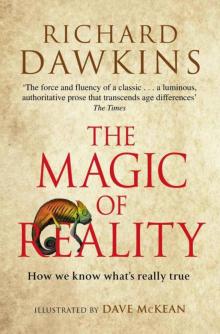- Home
- Richard Dawkins
The Greatest Show on Earth Page 35
The Greatest Show on Earth Read online
Page 35
But in total darkness the deleterious mutations that bombard the genes for making eyes are not penalized. Vision is impossible anyway. The eye of a cave salamander is like the moon, pitted with mutational craters that are never removed. The eye of a daylight-dwelling salamander is like the Earth, hit by mutations at the same rate as cave-dwellers’ eyes, but with each deleterious mutation (crater) being cleaned off by natural selection (erosion). Of course, the story of the cave-dweller’s eye isn’t only a negative one: positive selection comes in too, to favour the growth of protective skin over the vulnerable sockets of the optically deteriorating eyes.
Among the most interesting of historical relics are those features that are used for something (and so are not vestiges in the sense of having outlived their purpose), but seem badly designed for that purpose. The vertebrate eye at its best – say, the eye of a hawk or a human – is a superb precision instrument, capable of feats of fine resolution to rival the best that Zeiss or Nikon can deliver. If it were not so, Zeiss and Nikon would be wasting their time producing high-resolution images for our eyes to look at. On the other hand, Hermann von Helmholtz, the great nineteenth-century German scientist (you could call him a physicist, but his contributions to biology and psychology were greater), said, of the eye: ‘If an optician wanted to sell me an instrument which had all these defects, I should think myself quite justified in blaming his carelessness in the strongest terms, and giving him back his instrument.’ One reason why the eye seems better than Helmholtz, the physicist, judged it to be is that the brain does an amazing job of cleaning the images up afterwards, like a sort of ultra-sophisticated, automatic Photoshop. As far as optics are concerned, the human eye achieves its Zeiss/Nikon quality only in the fovea, the central part of the retina that we use for reading. When we scan a scene, we move the fovea over different parts, seeing each one in the utmost detail and precision, and the brain’s ‘Photoshop’ fools us into thinking we are seeing the whole scene with the same precision. A top-quality Zeiss or Nikon really does show the whole scene with almost equal clarity.
So, what the eye lacks in optics the brain makes up for with its sophisticated image-simulating software. But I haven’t yet mentioned the most glaring example of imperfection in the optics. The retina is back to front.
Imagine a latter-day Helmholtz presented by an engineer with a digital camera, with its screen of tiny photocells, set up to capture images projected directly on to the surface of the screen. That makes good sense, and obviously each photocell has a wire connecting it to a computing device of some kind where images are collated. Makes sense again. Helmholtz wouldn’t send it back.
But now, suppose I tell you that the eye’s ‘photocells’ are pointing backwards, away from the scene being looked at. The ‘wires’ connecting the photocells to the brain run all over the surface of the retina, so the light rays have to pass through a carpet of massed wires before they hit the photocells. That doesn’t make sense – and it gets even worse. One consequence of the photocells pointing backwards is that the wires that carry their data somehow have to pass through the retina and back to the brain. What they do, in the vertebrate eye, is all converge on a particular hole in the retina, where they dive through it. The hole filled with nerves is called the blind spot, because it is blind, but ‘spot’ is too flattering, for it is quite large, more like a blind patch, which again doesn’t actually inconvenience us much because of the ‘automatic Photoshop’ software in the brain. Once again, send it back, it’s not just bad design, it’s the design of a complete idiot.
Human eye
Detail of ‘photocells’ (rods and cones)
Or is it? If it were, the eye would be terrible at seeing, and it is not. It is actually very good. It is good because natural selection, working as a sweeper-up of countless little details, came along after the big original error of installing the retina backwards, and restored it to a high-quality precision instrument. It reminds me of the saga of the Hubble Space Telescope. You’ll remember that, when it was launched in 1990, the Hubble was discovered to possess a major flaw. Owing to an undetected fault in the calibration apparatus when it was being ground and polished, the main mirror was slightly, but seriously, out of shape. The telescope was launched into orbit, and then discovered to be defective. In a daring and resourceful move, astronauts were dispatched to the telescope, and they succeeded in fitting it with what amounted to spectacles. The telescope thereafter worked very well, and further improvements were effected by three more servicing missions. The point I am making is that a major design flaw – catastrophic blunder, even – can be corrected by subsequent tinkering, whose ingenuity and intricacy can, under the right circumstances, perfectly compensate for the initial error. In evolution generally, major mutations, even if they cause improvements in generally the right direction, almost always require a lot of subsequent tinkering – a sweeping-up operation by lots of small mutations that come along later and are favoured by selection because they smooth out the rough edges left by the initial large mutation. This is why humans and hawks see so well, despite the blundering flaw in the initial design. Helmholtz again:
For the eye has every possible defect that can be found in an optical instrument, and even some which are peculiar to itself; but they are all so counteracted, that the inexactness of the image which results from their presence very little exceeds, under ordinary conditions of illumination, the limits which are set to the delicacy of sensation by the dimensions of the retinal cones. But as soon as we make our observations under somewhat changed conditions, we become aware of the chromatic aberration, the astigmatism, the blind spots, the venous shadows, the imperfect transparency of the media, and all the other defects of which I have spoken.
UNINTELLIGENT DESIGN
This pattern of major design flaws, compensated for by subsequent tinkering, is exactly what we should not expect if there really were a designer at work. We might expect unfortunate mistakes, as in the spherical aberration of the Hubble mirror, but we do not expect obvious stupidity, as in the retina being installed back to front. Blunders of this kind come not from poor design but from history.
A favourite example, ever since it was pointed out to me by Professor J. D. Currey when he tutored me as an undergraduate, is the recurrent laryngeal nerve.* It is a branch of one of the cranial nerves, those nerves that lead directly from the brain rather than from the spinal cord. One of the cranial nerves, the vagus (the name means ‘wandering’ and it is apt), has various branches, two of which go to the heart, and two on each side to the larynx (voice box in mammals). On each side of the neck, one of the branches of the laryngeal nerve goes straight to the larynx, following a direct route such as a designer might have chosen. The other one goes to the larynx via an astonishing detour. It dives right down into the chest, loops around one of the main arteries leaving the heart (a different artery on the left and right sides, but the principle is the same), and then heads back up the neck to its destination.
If you think of it as the product of design, the recurrent laryngeal nerve is a disgrace. Helmholtz would have had even more cause to send it back than the eye. But, like the eye, it makes perfect sense the moment you forget design and think history instead. To understand it, we need to go back in time to when our ancestors were fish. Fish have a two-chambered heart, unlike our four-chambered one. It pumps blood forward through a big central artery called the ventral aorta. The ventral aorta usually gives off six pairs of branches, leading off to the six gills on either side. The blood then passes up through the gills where it becomes richly laced with oxygen. Above the gills, it is collected by six more pairs of blood vessels into another big vessel running down the middle, called the dorsal aorta, which feeds the rest of the body. The six pairs of gill arteries are evidence of the segmented body plan of the vertebrates, which is clearer and more obvious in fish than it is in us. Fascinatingly, it is very obvious in human embryos, whose ‘pharyngeal arches’ are clearly derived from ancestral gills, as one can
tell by looking at their detailed anatomy. Of course they don’t function as gills, but five-week human embryos can be regarded as little pink fishes, with gills. I can’t help wondering, once again, why whales and dolphins, dugongs and manatees have not re-evolved functional gills. The fact that, like all mammals, they have, in the pharyngeal arches, the embryonic scaffolding to grow gills suggests that it should not be too difficult to do so. I don’t know why they haven’t, but I’m pretty sure there’s a good reason, and somebody either knows it or knows how to research it.
Pharyngeal arches in human embryo
All vertebrates have a segmented body plan, but in adult mammals as opposed to embryos this is readily apparent only in the spinal region, where the vertebrae and the ribs, the blood vessels, muscle blocks (myotomes) and nerves all follow a pattern of modular repetition from front to back. Every segment of the vertebral column has two big nerves sprouting from the spinal cord on either side, called the dorsal root and the ventral root. These nerves mostly do their business, whatever it is, in the vicinity of the vertebrae from which they spring, but some shoot off down the legs and some down the arms.
The head and neck too, follow the same segmented plan, but it is harder to discern, even in fish, because the segments, instead of being neatly laid out in a fore-and-aft array as they are in the spinal column, have become all jumbled up over evolutionary time. It was one of the triumphs of nineteenth- and early twentieth-century comparative anatomy and embryology to discern the ghostly footprints of segments in the head. For example, the first gill arch in jawless fishes like lampreys (and in embryos of jawed vertebrates) corresponds to the jaws in those vertebrates that have them (that is, all modern vertebrates except lampreys and hagfishes).
Insects, too, and other arthropods such as crustaceans, as we saw in Chapter 10, have a segmented body plan. And it was a similar triumph to show that the insect head contains – again, all jumbled up – the first six segments of what, in their remote ancestors, would have been a train of modules just like the rest of the body. It was a triumph of late twentieth-century embryology and genetics to show that insect segmentation and vertebrate segmentation, far from being independent of each other as I was taught, are actually mediated by parallel sets of genes, the so-called hox genes, which are recognizably similar in insects and vertebrates and many other animals, and that the genes are even laid out in the correct serial order in the chromosomes! That is something none of my teachers would have dreamed of when I was an undergraduate learning, entirely separately, about insect and vertebrate segmentation. Animals of different phyla (for example, insects and vertebrates) are much more united than we ever used to think. And that, too, is because of shared ancestry. The hox plan was already sketched out in the grand ancestor of all bilaterally symmetrical animals. All animals are much closer cousins to each other than we used to think.
To return to the vertebrate head: the cranial nerves are believed to be the much-disguised descendants of segmental nerves, which, in our primitive ancestors, constituted the front end of a train of dorsal roots and ventral roots, just like those we still have sprouting from our spinal column. And the major blood vessels of our chest are the messed-about relics and remnants of the once clearly segmental blood vessels serving the gills. You could say that the mammalian chest has messed up the segmental pattern of the ancestral fish gills, in the same kind of way as, earlier, the fish head messed up the segmented pattern of even earlier ancestors.
Human embryos also have blood vessels supplying their ‘gills’, which are very similar to those of fish. There are two ventral aortas, one on each side, with segmental aortic arches, one for each ‘gill’ on each side, connecting to paired dorsal aortas. Most of these segmental blood vessels have disappeared by the end of embryonic development, but it is clearly apparent how the adult pattern is derived from the embryonic – and also from the ancestral – plan. If you were to look at a human embryo about twenty-six days after conception you would see that the blood supply to the ‘gills’ strongly resembles the segmental blood supply to the gills of a fish. Over the following weeks of gestation the pattern of blood vessels becomes simplified by stages and loses its original symmetry, and by the time the infant is born its circulatory system has become strongly left-biased – quite unlike the neat symmetry of the fish-like early embryo.
I won’t go into the messy details of which of our big chest arteries are the survivors of which of the six numbered gill arteries. All that we need to know, to understand the history of our recurrent laryngeal nerves, is that in fish the vagus nerve has branches that supply the last three of the six gills, and it is natural for them, therefore, to pass behind the appropriate gill arteries. There is nothing ‘recurrent’ about these branches: they seek out their end organs, the gills, by the most direct and logical route.
During the evolution of the mammals, however, the neck stretched (fish don’t have necks) and the gills disappeared, some of them turning into useful things such as the thyroid and parathyroid glands, and the various other bits and pieces that combine to form the larynx. Those other useful things, including the parts of the larynx, received their blood supply and their nerve connections from the evolutionary descendants of the blood vessels and nerves that, once upon a time, served the gills in orderly sequence. As the ancestors of mammals evolved further and further away from their fish ancestors, nerves and blood vessels found themselves pulled and stretched in puzzling directions, which distorted their spatial relations one to another. The vertebrate chest and neck became a mess, unlike the tidily symmetrical, serial repetitiveness of fish gills. And the recurrent laryngeal nerves became more than ordinarily exaggerated casualties of this distortion.
The picture opposite, from a 1986 textbook by Berry and Hallam, shows how the laryngeal nerve lacks a detour in a shark. To illustrate the detour in a mammal, Berry and Hallam chose – what more striking example could there be? – a giraffe.
In a person, the route taken by the recurrent laryngeal nerve represents a detour of perhaps several inches. But in a giraffe, it is beyond a joke – many feet beyond – taking a detour of perhaps 15 feet in a large adult! The day after Darwin Day 2009 (his 200th birthday) I was privileged to spend the whole day with a team of comparative anatomists and veterinary pathologists at the Royal Veterinary College near London, dissecting a young giraffe that had unfortunately died at a zoo. It was a memorable day, almost a surreal experience for me. The operating theatre was literally a theatre, with a huge plate-glass wall separating the ‘stage’ from the raked seats where veterinary students were watching for hours at a time. All day – it must have been right out of the normal run of their experience as students – they sat in the darkened theatre and stared through the glass at the brilliantly lit scene, listening to the words spoken by the dissecting team, who all wore throat microphones, as did I and the television production crew filming for a future documentary on Channel Four. The giraffe was laid out on the large, angled dissecting table, with one leg held high in the air by a hook and pulley, its enormous and affectingly vulnerable neck prominently exposed under bright lights. All of us on the giraffe side of the glass wall were under strict orders to wear orange overalls and white boots, which somehow enhanced the dream-like quality of the day.
Laryngeal nerve in giraffe and shark
It is testimony to the length of the detour taken by the recurrent laryngeal that different members of the team of anatomists worked simultaneously on different stretches of the nerve – the larynx near the head, the recurrence itself near the heart, and all stations between – without getting in each other’s way, and scarcely needing to communicate with each other. Patiently they teased out the entire course of the recurrent laryngeal nerve: a difficult task that had not, as far as we know, been achieved since Richard Owen, the great Victorian anatomist, did it in 1837. It was difficult, because the nerve is very narrow, even thread-like in its recurrent portion (I suppose I should have known that, but it came as a surprise, nevertheles
s, when I actually saw it) and it is easily missed in the intricate web of membranes and muscles that surround the windpipe. On its downward journey, the nerve (at this point it is bundled in with the larger vagus nerve) passes within inches of the larynx, which is its final destination. Yet it proceeds down the whole length of the neck before turning round and going all the way back up again. I was very impressed with the skill of Professors Graham Mitchell and Joy Reidenberg, and the other experts doing the dissection, and I found my respect for Richard Owen (a bitter foe of Darwin) going up. The creationist Owen, however, failed to draw the obvious conclusion. Any intelligent designer would have hived off the laryngeal nerve on its way down, replacing a journey of many metres by one of a few centimetres.
Quite apart from the waste of resources involved in making such a long nerve, I can’t help wondering whether giraffe vocalizations are subject to a delay, like a foreign correspondent talking over a satellite link. One authority has said, ‘Despite possession of a well developed larynx and a gregarious nature, the Giraffe is able to utter only low moans or bleats.’ A giraffe with a stutter is an endearing thought, but I won’t pursue it. The important point is that this whole story of the detour is a splendid example of how very far living creatures are from having been well designed. And, for an evolutionist, the important question is why natural selection does not do as an engineer would: go back to the drawing board and rejig things in a sensible manner. It is the same question we are meeting over and over in this chapter, and I have attempted to answer it in various ways. The recurrent laryngeal lends itself to an answer in terms of what economists call ‘marginal cost’.

 The Magic of Reality
The Magic of Reality The Extended Phenotype
The Extended Phenotype The God Delusion
The God Delusion The Selfish Gene
The Selfish Gene The Blind Watchmaker
The Blind Watchmaker The Greatest Show on Earth
The Greatest Show on Earth Climbing Mount Improbable
Climbing Mount Improbable Outgrowing God
Outgrowing God Brief Candle in the Dark
Brief Candle in the Dark The Greatest Show on Earth: The Evidence for Evolution
The Greatest Show on Earth: The Evidence for Evolution Science in the Soul
Science in the Soul An Appetite for Wonder
An Appetite for Wonder